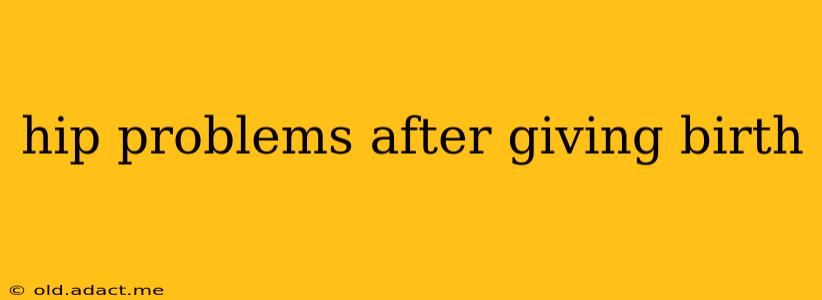Pregnancy and childbirth put immense stress on the body, and the hips are no exception. Many women experience hip pain after giving birth, often stemming from hormonal changes, weight gain, and the physical demands of labor and delivery. This comprehensive guide explores common hip problems after childbirth, their causes, and effective management strategies. Understanding these issues can empower you to seek appropriate care and find relief.
What Causes Hip Pain After Childbirth?
Several factors contribute to postpartum hip pain. The most significant culprits include:
-
Hormonal Changes: The surge in relaxin during pregnancy softens ligaments and joints to prepare the body for delivery. This loosening can lead to instability in the hip joints, making them more susceptible to pain and injury. These hormonal effects can persist for several months postpartum.
-
Weight Gain: Pregnancy brings significant weight gain, placing extra strain on the hips and lower back. This added weight can exacerbate existing hip conditions or trigger new ones.
-
Physical Changes: The shifting center of gravity during pregnancy alters posture and gait, putting additional stress on the hip joints. The act of childbirth itself can also cause muscle strain and ligament damage.
-
Diastasis Recti: While primarily affecting the abdominal muscles, diastasis recti (separation of the abdominal muscles) can indirectly contribute to hip pain by altering core stability and placing increased strain on the pelvic girdle and hips.
-
Posture: Poor posture, often exacerbated by pregnancy and caring for a newborn, can further strain the hips and contribute to pain.
What Are the Common Types of Hip Problems After Childbirth?
Postpartum hip pain can manifest in various ways. Some common conditions include:
-
Symphysis Pubis Dysfunction (SPD): This condition involves pain and instability in the joint connecting the two pubic bones. SPD can cause pain in the groin, hips, and lower back.
-
Sacroiliac (SI) Joint Dysfunction: Pain in the SI joint, located where the sacrum (tailbone) meets the pelvis, is another common postpartum complaint. This pain can radiate to the hips, buttocks, and legs.
-
Muscle Strains and Tears: The physical exertion of labor and delivery, combined with the weakened ligaments and muscles from pregnancy, can lead to muscle strains or tears around the hips.
-
Osteoarthritis: While not directly caused by childbirth, pregnancy can accelerate the onset or worsen pre-existing osteoarthritis in the hip joint.
How is Hip Pain After Childbirth Diagnosed?
Diagnosis typically involves a physical examination by a healthcare professional. This examination may include assessing your range of motion, palpating the affected areas, and evaluating your gait. Imaging tests, such as X-rays or ultrasounds, may be used to rule out other conditions or identify specific injuries.
What Are the Treatment Options for Postpartum Hip Pain?
Treatment options vary depending on the underlying cause and severity of the pain. Common approaches include:
-
Physical Therapy: Physical therapy is often the first-line treatment. A physical therapist can design a personalized exercise program to strengthen core muscles, improve hip stability, and alleviate pain.
-
Manual Therapy: Techniques like chiropractic adjustments or osteopathic manipulation may help restore proper joint alignment and reduce pain.
-
Medication: Over-the-counter pain relievers like ibuprofen or acetaminophen can help manage pain and inflammation. In some cases, a doctor may prescribe stronger pain medication or anti-inflammatory drugs.
-
Rest and Ice: Resting the affected area and applying ice packs can help reduce pain and swelling.
-
Posture Correction: Improving posture through exercises and mindful awareness can significantly reduce strain on the hips.
How Long Does Hip Pain After Childbirth Last?
The duration of postpartum hip pain varies greatly depending on the cause and the individual's response to treatment. For many women, pain gradually subsides within a few months. However, for others, it may persist for longer periods, requiring ongoing management.
Can I Prevent Hip Problems After Giving Birth?
While not all hip problems are preventable, taking proactive steps during and after pregnancy can significantly reduce your risk:
-
Pelvic Floor Exercises: Strengthening your pelvic floor muscles before, during, and after pregnancy can improve stability and reduce the risk of hip and pelvic pain.
-
Maintain a Healthy Weight: Maintaining a healthy weight throughout pregnancy can minimize the strain on your hips and joints.
-
Practice Good Posture: Maintaining good posture can help distribute weight evenly and reduce strain on the hips.
-
Seek Professional Guidance: If you experience any hip pain during or after pregnancy, consult a healthcare professional for timely intervention.
This information is for general knowledge and does not constitute medical advice. Always consult with a healthcare professional for diagnosis and treatment of any medical condition.
